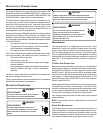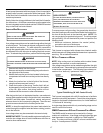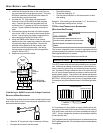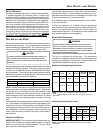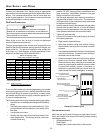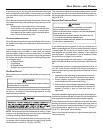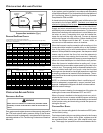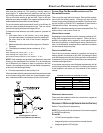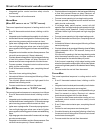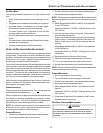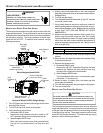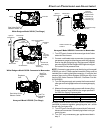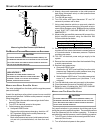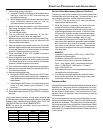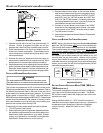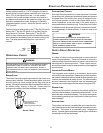
24
S
TART
-
UP
P
ROCEDURE
AND
A
DJUSTMENT
• Integrated ignition control monitors safety circuits
continuously.
• Furnace awaits call from thermostat.
HEATING M ODE
(MODE DIP SWITCH IS SET TO “1 STG” POSITION)
The normal operational sequence in heating mode is as fol-
lows:
• R and W thermostat contacts close, initiating a call for
heat.
• Integrated control module performs safety circuit checks.
• Induced draft blower is energized for 15 second pre-purge
period causing pressure switch contacts to close.
• Igniter warm up begins after 15 second prepurge expires.
• Low and high-stage gas valves open at end of igniter
warm up period, delivering gas to burners and establishing
flame.
• Integrated control module monitors flame presence. Gas
valve will remain open only if flame is detected.
• Circulator blower is energized on high heat speed following
a fixed thirty second blower on delay. Electronic air
cleaner terminals are energized with circulator blower.
• Furnace operates; integrated control module monitors
safety circuits continuously.
• R and W thermostat contacts open, completing the call
for heat.
• Gas valve closes, extinguishing flame.
• Induced draft blower is de-energized following a fifteen
second post purge.
• The circulator blower remains on high speed for the
selected heat off delay period.
• Furnace awaits the next call from thermostat.
(MODE DIP SWITCH IS SET TO “2 STG” POSITION)
The normal operational sequence in sequence is as follows:
• R and W thermostat contacts close, initiating a call for
heat.
• Integrated control module performs safety circuit checks.
• Induced draft blower is energized for 15 second prepurge
period causing pressure switch contacts to close.
• Igniter warm up begins after 15 second prepurge expires.
• Low and high-stage gas valves open at end of igniter
warm up period, delivering gas to burners and establishing
flame.
• High-stage gas valve closes after five seconds; low-stage
gas valve remains open.
• Integrated control module monitors flame presence. Gas
valve will remain open only if flame is detected.
• Circulator blower is energized on low heat speed following
a fixed thirty second blower on delay. Electronic air
cleaner terminals are energized with circulator blower.
• Furnace is now operating in low-stage heating mode.
• Furnace operates; integrated control module monitors
safety circuits continuously.
• If low-stage delay period expires, control will shift
operation from low-stage heating mode operation to high-
stage heating mode operation. Control will energize
circulator blower high heat speed and high stage gas
valve.
• Furnace is now operating in high-stage heating mode.
• R and W thermostat contacts open, completing the call
for heat.
• Induced draft blower is de-energized following a fifteen
second post purge.
• Circulator blower is de-energized following a heat off delay
period (selectable 100 or 150 seconds; factory set at
150 seconds).
If the furnace is operating in the low-stage heating mode
when thermostat contacts open, circulator remains at
low heat speed for the selected delay off period.
If the furnace is operating in high-stage heating mode
when the thermostat contacts open, the circulator blower
remains at high heat speed for the selected heat off delay
period.
• Furnace awaits the next call from thermostat.
COOLING M ODE
The normal operational sequence in cooling mode is as fol-
lows:
• R and Y thermostat contacts close, initiating a call for
cool.
• Integrated control module performs safety circuit checks.
• Outdoor fan and compressor are energized.
• Circulator blower is energized on cool speed following a
fixed five second on delay. Electronic air cleaner
terminals are energized with circulator blower.
• Furnace circulator blower and outdoor cooling unit run,
integrated control module monitors safety circuits
continuously.
• R and Y thermostat contacts open, completing the call
for cool.
• Outdoor fan and compressor are de-energized.
• Circulator blower is de-energized following a fixed forty
five second cool off delay period. Electronic air cleaner
terminals are de-energized.
• Furnace awaits the next call from thermostat.



